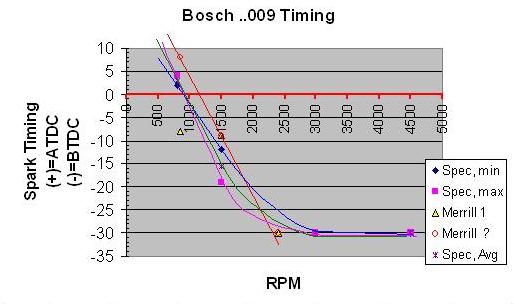Merrill, you said in your most recent post "
I have a slight pinging under acceleration."
And in your other post you stated at idle 850 rpm "
8 deg BTDC with out vac
1500 11 deg Btdc with vacuum , 9 deg BTDC with out vac. I reached 30 deg BTCD at 2300 - 2400 rpm not 3000 rpm."
All the following is discussed based on
without vacuum timing.
Your data makes more sense IF your stated 8 degr BTDC at idle (850 rpm) were in fact 8 degr ATDC. Are you sure you're reading it right? The difference between idle (850 rpm) and 1500 rpm by your measures is only 1 degree, whereas the spec's without vacuum should have a 14-15 degr. difference. IF your idle value were in fact 8 degr ATDC then the difference between idle and 1500 rpm is 17 degr. Furthermore, your pinging condition would also make sense since the pinging occurs when the sparks too far advanced. If your idle timing is actually 8 degr BTDC, then both your idle and 1500 rpm timing are too advanced ... by 6 -7 degr. This is also to say that your point gap is opening 6-7 degr too soon.
Rotating the distributor in the direction which retards the spark --- so that the 1500 rpm timing is at 12 - 19 deg BTDC will also / should also shift your idle (850 rpm) spark to 1-2 degr ATDC.
If indeed your idle timing is at 8 degr BTDC and 1500 rpm's at 9 degr BTDC, then something's really wrong since the rate of change of points opening with increasing RPM is far too little... only 1 degr change over an increase in rpm of ~750. The points spring determine rate at which the points can close, which determines how fast the points can close when the distributor cam lobe lets them. The rate of closure times the static point gap distance determines the time it takes to close the points. The time it takes to close the points at any given rpm will increase when the point gap is larger, and time it takes will decrease if the point gap is reduced.
As the distributor cam rotating velocity increases, there's an increasing lag in time (based on the mass of the points and the point spring rate) between the point in time the cam lobe lets the points close and the time it takes for them to actually close... hence the closure occurs relatively later with increasing rpm. The rate of change of point gap closure with increasing rpm from 800 to 1500 should be ~+2 to +2.6 degr per 100 rpm increase in engine speed. Your indicated point gap closure rate with increasing rpm is only 0.15 degr/100 increase in rpm!
On the other hand, IF your idle timing is actually at 8 degr ATDC (instead of 8 degr BTDC as you've stated) then the rate of closure with increasing rpm is +2.6 degr per 100 rpm.... basically right at the upper end of the spec. If the point gap were reduced a tad, the rate of change of closure timing with increasing rpm would decrease.
There are 2 possibilities I can think of...
1) If the actual timing at 850 rpm is as I've conjectured... 8 degr ATDC instead of 8 degr BTDC as you're stating... then your timing is too advanced by ~6 - 7 degrees at idle. If so, you need to rotate the distributor body until you're getting 2-4 degr ATDC at idle... (subtract 1 degree for every 50 rpm your idle is over 800 rpm... so at 850 rpm your setting should be 1-3 degrees ATDC).
2) If the actual timing at idle (850 rpm) is as you've stated, then the points are closing far too fast at idle relative to their closure at 1500 rpm. If this is the case, then either your distributor body is rotating when you increase rpm to 1500 rpm after setting timing at 850 rpm, OR your point gap's far to small when you set them statically. Use a dwell meter (use the 6 cyl. engine markings for dwell) to set your point gap so that the dwell is 38 (+3, -1 degr.) at engine cranking speed. The static point gap (at TDC .... moveable point cam on top of distributor shaft cam lobe)should be in the range 0.3 - 0.4 mm (12 - 15 mils ==> 0.012 - 0.015 inches).
For the time being, forget about the vacuum advance magnitudes.... get
1) point gap set right,
2) dwell angle set right at idle (800 rpm) without vacuum.
3) timing right at idle without vacuum (2- 4 deg ATDC at 800 rpm or 1-3 degr at 850 rpm).
When the above are correct, then check 1500 and 3k rpm timing ... all the above using a strobe. They should all be within the spec'ed allowances since they're without vacuum... before moving to the vacuum checks. If the timing values aren't correct at 1500, 3k and 4.5k, then we'll need to work on what's wrong before moving on. By the way, there are no spec's for the timing values with vacuum applied.
The BBB instructions for changing the vacuum range is described below.
From the BBB:
To adjust the vacuum control range, the total adjustment range can be increased by backing off the stop nut on the pull rod that connects the diaphragm in the vacuum box with the distributor plate, and the range can be decreased by screwing the stop nut in.Here's the chart that shows spec'ed timing vs rpm, and 2 versions of your timing values... one with the values you reported, and one denoted "Merrill ?" where I've plotted the timing assuming your 850 rpm idle timing is actually at 8 degr ATDC instead of 8 degr BTDC as you reported it.

Longtooth
67 250SL US #113-043-10-002163
The 6% Club - Best of the Best
'02 SL500 Sport